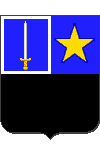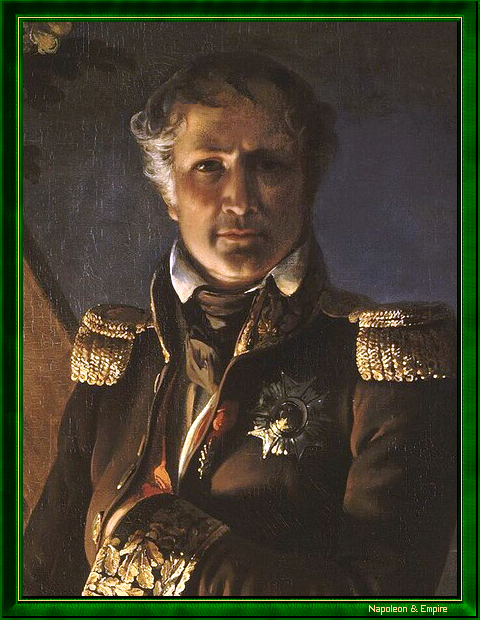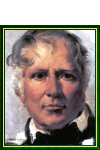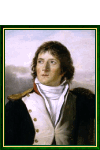Count of the Empire
Pronunciation:

From a young age, Laurent de Gouvion displayed an artistic streak. Born into a bourgeois family with several soldiers on April 13, 1764 in Toul (Lorraine), Gouvion did not pursue a career in the military as his father wished but instead followed his passion for painting. After taking drawing courses, he spent two years in Rome when he was 28 where he studied the Italian masters. Forced to return to France by financial constraints, he was admitted to Nicolas Guy Brenet's atelier.
At the same time, François-Joseph Talma and his other actor friends encouraged him to take to the stage, first as an amateur and the professionally. His ringing voice, good looks and solid physique made him a natural, but stage-fright forced him to retire from the theatre.
Given that his painting was not progressing either, he decided to approach a distant relative, Captain Gouvain, soon after the Storming of the Bastille. Now a major general in the National Guard of Paris thanks to Gilbert du Motier de La Fayette, the elder Gouvain found Laurent a job as a pen pusher in his commander's headquarters.
After August 10, 1792, he joined a battalion of Parisian volunteers. In order to differentiate himself from his relative who had a bad reputation among patriots, he added his mothers maiden name to his.
Elected a captain, he was seconded the Planning and Fortification Office in the headquarters of General Adam Philippe de Custine where his knowledge of drawing proved very useful. He was promoted to adjutant general which a rank higher than a colonel but reserved for officers serving in administration roles or at headquarters. In this role, he often covered for his superiors during 1793 as they were under enormous pressure from the Convention on pain of death. He performed so well that he was promoted against his wishes to brigadier general on June 5, 1794. In order to avoid the promotion, he even went so far as to try to hide behind his relative's disrepute. Unfortunately for him, less than a week later he was made a général de division (major general) on June 11.
From that point on, he played an important role in the operations along the Rhine. He participated in the blockade of Mayence (1794-1795) and organized the retreat that followed. In 1796, he orchestrated the victories at Rastadt (July 5) and Ettlingen (July 9), captured Stuttgart (July 18) and defeated Kehl a few months later in 1797. With the death of Lazare Hoche, he took command of the Rhine and Moselle Army and invaded the commune of Basel at the end of 1797.
In March 1798, he replaced André Masséna as the Commander-in-Chief of the army in Rome by virtue of the fact that he was the only officer who spoke Italian. In any case, he managed to stabilize the near anarchy in that city after the officer's mutinied against Masséna. A few months later he was forced to resign his commission as he opposed the abuses committed by the new authorities brought to power by France at the expense of the Roman aristocracy. He was quickly denounced to the Directory and commanded to return within two weeks or face the penalty of being branded an émigré.
He was then sent to Germany to command the left flank of the Danube army and fought at Stockach on March 25, 1799. Next, he returned to Italy as the Governor of Genoa where he worked to bring order back to a city nearly compromised by Joubert's failures. The same day the new Consular Constitution took effect (December 15), he won an important victory at Albaro and was rewarded by Napoleon Bonaparte with a Sabre of Honour.
He moved next to the Rhine Army as second-in-command to Jean Victor Marie Moreau. Unfortunately, the two men developed an immediate dislike for each other. Gouvion-Saint-Cyr did not hesitate to openly and heatedly criticize his commander's battle plans making the situation untenable. After being blamed for every failure, Gouvion-Saint-Cyr finally requested leave from active service shortly after winning the Battle of Biberach on May 9, 1800.
Napoleon Bonaparte made him a Councillor of State before sending him to oversee the invasion of Portugal by a combined force of French and Spanish troops in 1801. He subsequently replaced Lucien Bonaparte as ambassador to Spain (November 2, 1801) as the latter's blunders had forced his resignation.
After returning to France and a brief stint in the military section of the Council of State, he was tasked with occupying the Kingdom of Naples in May 1803: a task he executed with near perfection. However, given his doubts with regard to the Empire, he had his own name struck from the list of Marshals though nobody questioned his right to this privilege due to his service, talents and reputation.
At the end of 1805, he evacuated Naples in order to meet Masséna in northern Italy and fight the Third Coalition. He won the Battle of Castelfranco on November 24 and this became his favourite operation as his orders had been followed to the letter.
At the beginning of the next year, he refused to be subordinated to Masséna as he was preparing to once again invade the Kingdom of Naples. He was unable to collaborate with the Marshal and he asked to return to France in August 1806.
Napoleon I sent him to command the camp in Boulogne from December 1806 to August 1808. He left to travel to Catalonia where he would achieve several major tactical successes. On December 17, he succeeded in his objective of accessing Barcelona. However, he failed to press his advantage to Napoleon's satisfaction and had his command transferred to Augereau. Saint-Cyr's next mistake was leaving his post before the arrival of his successor. In his defence it has to be noted that his replacement, who was aware of the nature of the war in Spain, was in no hurry to arrive as he still had not appeared two months after his appointment.
As his departure coincided with several serious setbacks for which he was blamed, Saint-Cyr was subsequently arrested. Refusing to explain himself, he remained without a commission until 1811.
He returned to the Council of State that year and was then called back to active service in 1812 when Napoleon I needed all of his generals for the Russian Campaign. In command of the 6th corps of the Grande Armée, he was victorious at Polotsk (August 18, 1812) and finally received a marshal's baton.
During the German Campaign of 1813, he commanded the 14th corps made up of recently mobilized young recruits. He defended Dresden with these troops after the Battle of Leipzig which took place from October 16 to 19. Desperate for reinforcements, he capitulated 10 days after the rest of the French army had crossed back over the Rhine on November 11.
He was confined in Carlsbad as per the terms of his surrender and was only released after the fall of the Empire. Upon his return to France he was elevated to the peerage and retired to the country. He remained neutral during the Hundred Days even after meeting Napoleon I at the Tuileries Palace and only returned to Paris after the Battle of Waterloo to unsuccessfully advocate an all-out war against the Allies.
In the new regime, he was twice appointed Minister of War (from July 8 to September 12, 1815 and from September 12, 1817 to November 12, 1819) and once Minister of the Navy (from June 23 to September 12, 1817). He left both roles without regrets as he had presided over a remarkable reorganization of the army and sponsored a recruitment bill that bore his name. Louis XVIII made him a marquis which was a promotion above his rank of count during the Empire which he had held since 1808. He devoted his final years to writing his memoirs in his château de Reverseaux in Eure-et-Loir.
He died from apoplexy in Hyères in the Var region on March 17, 1830.
"Count Laurent de Gouvion-Saint-Cyr" by Emile Jean Horace Vernet a.k.a. Horace Vernet (Paris 1789 - Paris 1863).

A soldier by necessity with the soul of an artist, he never like war. Napoleon I understood this. At Gourgaud the Emperor said of him: He was loved by those who served under him because he rarely sought out a fight and was economical in his decisions.
The name Gouvion-Saint-Cyr can be found on the 13th column (east side) of the Arc de Triomphe.
His magnificent tomb can be found in the 37th division of the Père Lachaise Cemetery in Paris.
Other portraits

Enlarge
"Laurent de Gouvion-Saint-Cyr". Nineteenth century French school.

Enlarge
"Laurent Gouvion-Saint-Cyr in 1792", painted 1835 by Georges Rouget (Paris 1781 - Paris 1869).

Enlarge
"Laurent de Gouvion-Saint-Cyr". Nineteenth century etching.